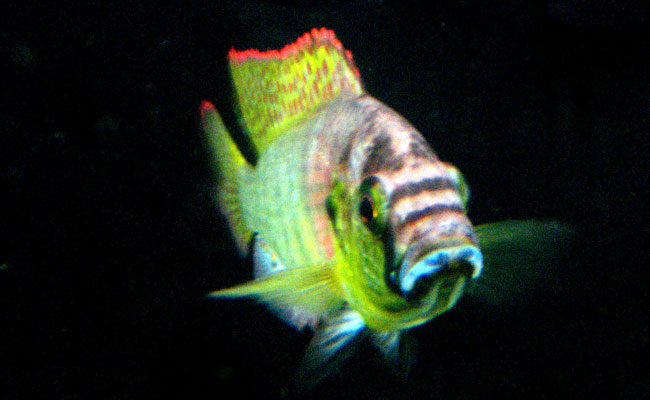Fish Capable of Human-like Logic

Fish have the reasoning capacity of a 4- or 5-year-old child when it comes to figuring out who among their peers is "top dog," new research shows.
Stanford University scientists made the discovery—said to be the first demonstration that fish can use logical reasoning to figure out their social pecking order—by studying fights among small, highly territorial, spiny-finned fish called cichlids, common in freshwater in tropical Africa, including in Lake Tanganyika in central Africa.
Logan Grosenick, a graduate student in statistics, and his colleagues found that a sixth fish could infer or learn indirectly which were the 1st through 5th strongest simply by observing fights among them in adjacent, transparent tanks, rather than by directly fighting each fish itself or seeing each fish fight all four others [image].
This type of reasoning, called transitive inference (TI), is a developmental milestone for human children, showing up nonverbally as early as ages 4 and 5; it also has been reported in monkeys, rats and birds. It allows thinkers to reason that if A is bigger than B, and B is bigger than C, then A is also bigger than C.
Fishy thoughts
Anthropomorphizing animals, or casting human intentions on them, is a mistake, Grosenick said, but it's a philosophical matter as to whether the cichlids' ability to infer rankings is the same as similar reasoning in humans.
"They are making correct logical inferences on an abstract representation of their world, which would usually be called 'reasoning' in humans," he said.
Sign up for the Live Science daily newsletter now
Get the world’s most fascinating discoveries delivered straight to your inbox.
Biologist Russell D. Fernald, one of Grosenick's colleagues on the study, said that fish thinking is very different from that of humans.
"The capacity shown here is a necessary precondition for reasoning, but having this capacity does not mean these fish actually reason or do any other specific logical tasks," he told LiveScience.
Food fights
Male cichlids (Astatotilapia burtoni) regularly fight aggressively to establish real estate from a pool of limited territory, to secure control of scarce food resources and to maintain a location for spawning with females.
The ability to know in advance with which peer they could pick and win a fight is an advantage for these fish, Fernald said.
To learn about fish learning, Grosenick designed experiments that staged dozens of fights across 11 days among five different fish (known to the scientists as A, B, C, D, and E, with A being the strongest and E the weakest) in a circle of transparent, plastic tanks that allowed a “bystander” fish in a center tank to observe each fight as it took place. A fought B, B fought C and so on.
Later on in an open tank, the bystander got to choose between whether to hang out with either the A fish or the E fish, even though the bystander never saw A fight E. The bystander also was tested to choose between the B fish and the D fish, which had never faced off.
Bystander fish in experiments typically chose the weakest fish—either D or E (those that had lost the most fights)—as their preferred companion, making the safest choice for their long-term survival and ability to reproduce.
This preference shows, the team writes in the Jan. 25 issue of the journal Nature, that the fish used observation and logical reasoning to infer or deduce the relative ranking among the five fighting fish.
- Amazing Animal Abilities
- 10 Amazing Things You Didn't Know about Animals
- Scientists: You Learn Without Knowing It
- Venomous Fish Image Gallery
- Freaky Fish Image Gallery
Robin Lloyd was a senior editor at Space.com and Live Science from 2007 to 2009. She holds a B.A. degree in sociology from Smith College and a Ph.D. and M.A. degree in sociology from the University of California at Santa Barbara. She is currently a freelance science writer based in New York City and a contributing editor at Scientific American, as well as an adjunct professor at New York University's Science, Health and Environmental Reporting Program.










